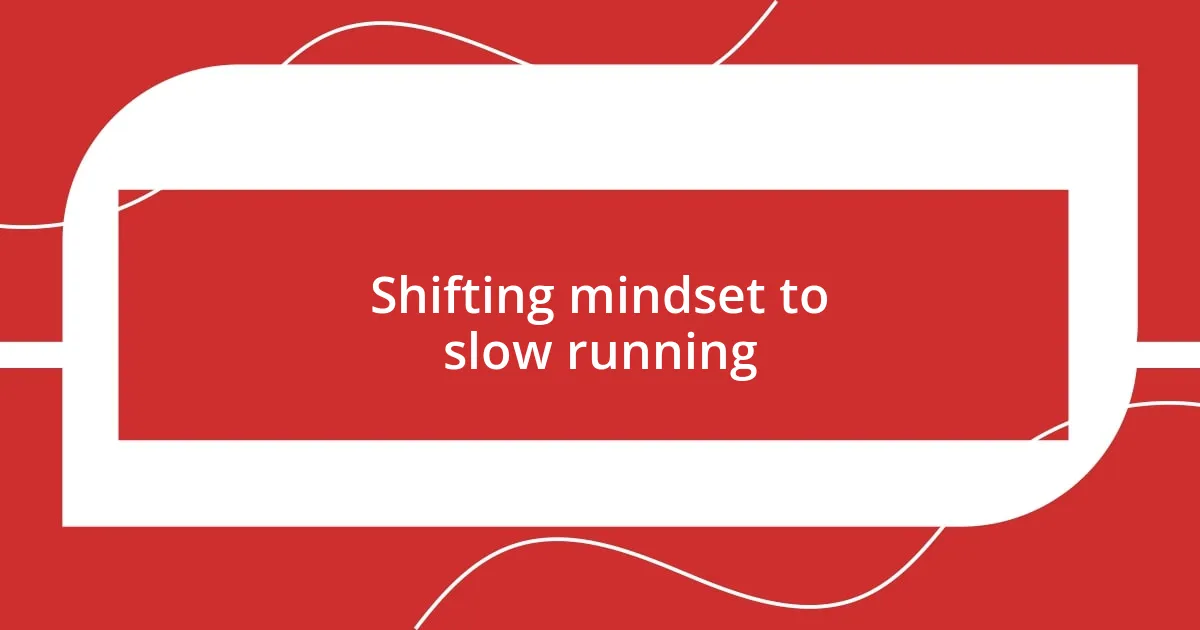Key takeaways:
- Slow running fosters physical recovery, mental clarity, and emotional well-being by allowing runners to connect with their bodies and surroundings.
- Shifting the mindset to embrace enjoyment, mindfulness, and community significantly enhances the running experience, making it more about the journey than speed.
- Setting achievable, flexible goals and celebrating small milestones fosters motivation and a love for running over time.
- Overcoming challenges through personal reflection and community support transforms the slow running journey into a fulfilling experience.

Understanding slow running benefits
Engaging in slow running has shown me not just a physical transformation but a mental shift. I remember my first few sessions, feeling the rhythm of my breath syncing with my footsteps—it was as if I was reconnecting with my body in a way I hadn’t experienced before. Have you ever felt that beautiful flow while moving at your own pace? It’s like a calming meditation in motion, allowing me to clear my mind and reduce stress.
The beauty of slow running lies in its accessibility. I recall a day when I encouraged a friend to join me, emphasizing that speed doesn’t equate to success. As we jogged side by side, she discovered that running slower allowed her to enjoy the environment around us—the rustling leaves, the chirping birds, and the gentle breeze. Isn’t it remarkable how slowing down can help us savor the little things we often overlook?
Moreover, slow running has become a powerful tool for recovery. After pushing my limits during a race, I turned to slower paces to heal my body. The supportive nature of slow running gave me the space to build endurance without risking injury. How powerful is it to realize that embracing a gentler approach not only benefits our physical health but also nurtures our emotional well-being?

Shifting mindset to slow running
Transitioning my mindset to slow running was a journey in itself. Initially, I felt the pressure to keep up with faster runners, pushing myself to meet perceived standards. Then, a lightbulb moment occurred during one of my slower runs when I decided to focus on the serene beauty around me—colors, sounds, and sensations. It dawned on me that by running slower, I wasn’t just nurturing my body; I was also creating a daily sanctuary for my mind.
I learned to embrace these key shifts in my running mindset:
- Redefining Success: I realized that enjoyment and connection to nature could be goals, not just speed.
- Celebrating Progress: Each slow run became a milestone; I didn’t need to compare my pace to anyone else.
- Mindfulness Practice: I found that focusing on my breath and surroundings enhanced my mental clarity and reduced anxiety.
- Building Community: Running at a slower pace opened doors to new friendships with others who shared the same appreciation for leisure over speed.
- Listening to My Body: I began to trust my instincts, allowing myself to slow down when my body felt fatigued or in need of a break.
This shift transformed my running into something that felt meaningful and fulfilling, embracing the process rather than fixating on outcomes.

Setting achievable slow running goals
Setting achievable goals in slow running is essential for anyone looking to enhance their experience. I remember my early days, setting overly ambitious targets that often left me frustrated. Shifting my focus to smaller, manageable goals, such as running for 10 minutes without stopping, truly transformed my outlook. This approach allowed me to celebrate each little victory, making every run a rewarding experience instead of a daunting task.
Moreover, mixing short-term and long-term goals can create balance in your slow running journey. For instance, while I set a long-term objective to complete a 5K, my short-term goal was to increase my distance gradually each week. This strategy kept my motivation high while ensuring I remained attuned to my body’s needs. I gradually learned to appreciate the process, discovering that setting achievable goals nurtured my love for running more than any fancy medal ever could.
Lastly, it’s vital to keep your goals flexible and adaptable. Life can throw many surprises at us, and I’ve had runs where I simply didn’t feel like hitting my target. Instead of forcing it, I learned to listen to my body, adjusting my goals as needed. This adaptability not only reinforced my commitment to slow running but also deepened my self-awareness. Isn’t it interesting how listening to ourselves can lead to a more enjoyable running experience?
| Goal Type | Description |
|---|---|
| Short-Term Goals | Focus on immediate achievements, like running for a specific period or distance. |
| Long-Term Goals | Set broader aspirations, such as completing a race or increasing overall mileage. |
| Flexible Goals | Adjust based on how you feel, allowing for self-care and realistic expectations. |

Creating a slow running routine
Creating a slow running routine is all about aligning your pace with your comfort level and lifestyle. I recall the first time I consciously decided to run at a leisurely pace. I felt liberated when I no longer concerned myself with checking my watch every few minutes. Instead, I allowed the rhythm of my feet striking the ground to dictate my speed, enjoying the sounds of nature and my own breath. That shift made my runs feel less like a chore and more like a tranquil escape.
One essential aspect of developing a slow running routine is establishing consistency. I chose to run at the same time each week, which helped cement it as part of my lifestyle. At first, I struggled, but soon it became a cherished ritual. I remember feeling the weight of the world lift with each slow lap around the park. Finding the right route—one that offered peaceful scenery—transformed my experience into something spiritual, fueling my desire to lace up my shoes day after day.
Listening to my body became a game-changer in my slow running journey. I often asked myself how I truly felt on any given day, and sometimes, I simply didn’t have the energy to run. Learning to honor those feelings taught me that it’s okay to adjust my routine. There were days when a leisurely jog turned into a leisurely walk instead, but I discovered that every step—whether running or walking—brought me closer to my goal of nurturing my overall health. Have you ever felt that sense of freedom when you embraced a slower pace? I surely did, and it’s a feeling I cherish every time I hit the trail.

Incorporating mindfulness in running
Incorporating mindfulness into my running transformed the way I experienced each moment on the trail. I remember one particularly serene morning when I decided to focus solely on my breathing and the rhythm of my feet. I found it fascinating how tuning into these sensations helped me forget about everyday worries. Isn’t it amazing how simply being present can make a run feel like a moving meditation?
One technique I adopted was to create a mantra while running. As I put one foot in front of the other, I’d repeat phrases like “I am strong” or “I am free.” This practice kept me grounded, fostering a sense of peace that overpowered any urge to rush. During a challenging hill run, I realized that focusing on my breath and my mantra turned what could have been a tedious chore into a deeply fulfilling experience. Have you ever tried finding strength in words while you run?
Finally, I made it a point to take in my surroundings during my runs. Rather than zoning out, I began to notice the vibrant colors of the changing leaves and the sound of the wind rustling through the trees. This approach not only made my runs more enjoyable, but it also deepened my appreciation for nature and the world around me. Some days, I’d even stop to watch a bird or admire a flower, realizing that embracing these small moments can amplify the joy of running. Don’t you think these little observations can turn a routine sprint into a personal journey?

Tracking progress and celebrating milestones
Tracking my progress in slow running was both a revealing and rewarding part of my journey. I started using a simple app to monitor my distance and pace, but I quickly realized the real value lay in the way I felt after each run. Each time I logged a new distance, a surge of pride washed over me. Have you ever celebrated small victories? For me, those moments reinforced my commitment to a healthier lifestyle, reminding me that every step contributed to my overall well-being.
As I celebrated my milestones, I found joy in the little things. One day, after reaching a month of consistent running, I treated myself to a new pair of running shoes. I still remember how I felt lacing them up for the first time; it was like wearing a badge of honor. It made me reflect on how significant milestones—whether it’s a week of consistency or a personal best—warrant celebration. Isn’t it fascinating how a small reward can enhance our motivation to continue?
I also began to share my progress with friends and family, which made the experience even more fulfilling. Their enthusiasm fueled my passion, and every time someone congratulated me, it felt like a collective achievement. I learned that community support amplifies individual effort. So, what about you? Have you considered how sharing your journey could create stronger connections with those around you? Each conversation not only inspired me to keep going, but it also sparked discussions about our shared experiences and aspirations.

Overcoming challenges in slow running
I’ll admit, embracing slow running came with its own set of challenges. There were days when the urge to push myself harder loomed large, especially when I saw faster runners zipping past me. I often questioned if I was truly benefiting from my slower pace. But you know what? Over time, I learned to silence that nagging voice by reminding myself that every runner’s journey is uniquely their own. Have you ever felt that comparison trap?
One particularly tough moment occurred during a weekend long run where I felt sluggish and frustrated. Instead of giving in and abandoning my run, I chose to focus on my breathing and my purpose for running—health and well-being. I remember noticing the path beneath my feet and how the sun was breaking through the trees. It was after that experience that I understood slow running is not just about speed; it’s about connecting with oneself and finding joy in the process. Isn’t it liberating to shift your perspective like that?
Eventually, I realized that sharing my slow running journey with a local running group helped me overcome my obstacles. Their encouragement reassured me that slow running was a valid and enriching path. One member even shared how they struggled at first too, which created an instant bond. This camaraderie made all the difference. Have you found that community support can help lift you during tough times? That connection turned my challenges into shared experiences, making each slow step feel lighter and more fulfilling.















